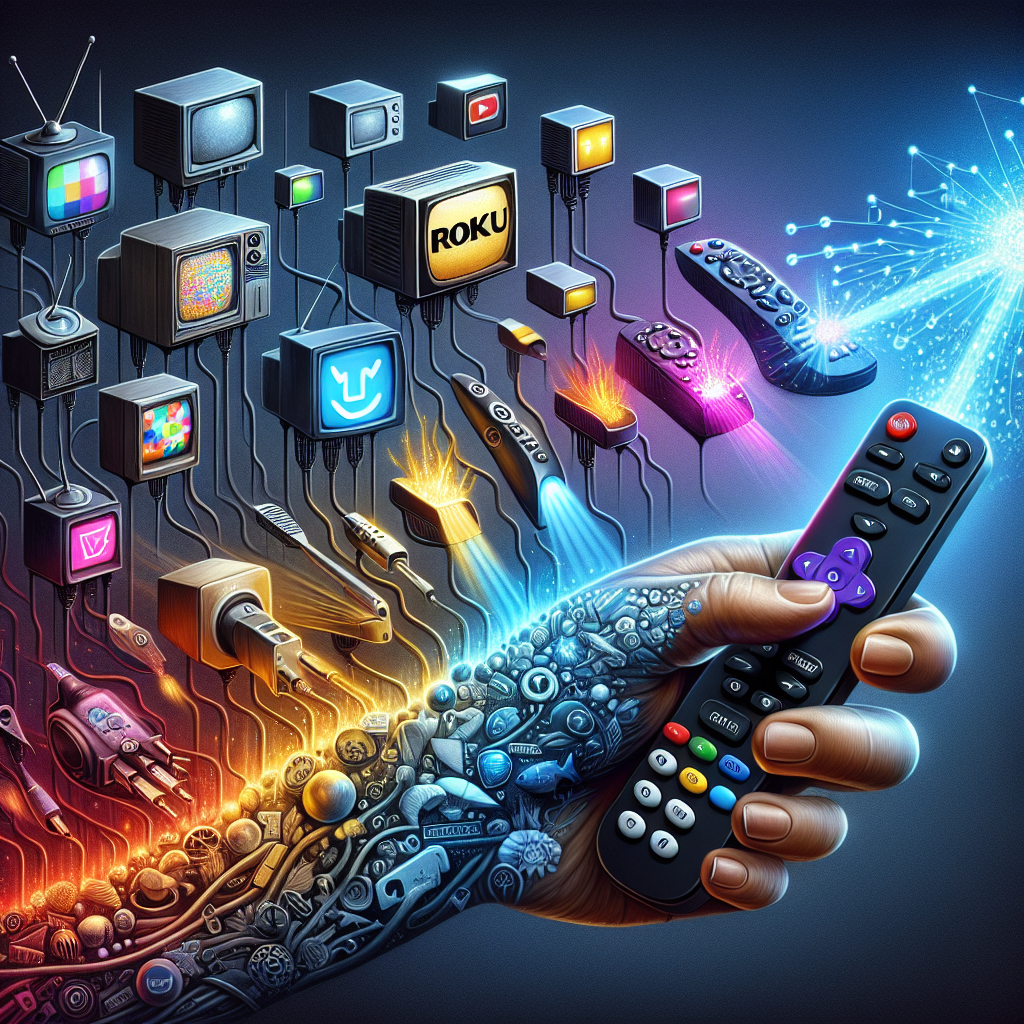The Evolution of Streaming: How Roku and Disney are Shaping the Future of Television Advertising
In recent years, the landscape of television and advertising has undergone a seismic shift, driven largely by the rapid evolution of streaming platforms and the rise of connected TV (CTV) and over-the-top (OTT) content. At the forefront of this transformation are industry giants like Roku and Disney, who are not only redefining how we consume content but also how advertisers reach audiences. Roku’s impressive third-quarter results, highlighted by a 20% revenue growth and a significant increase in active accounts, underscore its role as a major player in this new era of television. The launch of Roku-branded smart TVs has propelled its TV sales unit growth beyond industry expectations, contributing to a total net revenue of $912 million for Q3, up from $761 million the previous year. This growth is not just a testament to Roku’s robust business model but also an indicator of the broader trends shaping the future of television.
Roku’s success can be attributed to several key factors, including strong performance in content distribution and video advertising. Device revenue alone saw a remarkable 33% year-over-year growth, reaching $125 million. This surge in revenue is indicative of the growing consumer demand for streaming devices and platforms that offer a seamless and personalized viewing experience. Moreover, Roku’s platform revenue, which includes digital advertising sales and content distribution, grew by 18% from the previous year, totaling $787 million. Despite a challenging advertising market, Roku has managed to rebound strongly in video advertising, thanks in part to its diversification of advertiser demand sources and expanding partnerships. By integrating with over 30 programmatic partners, Roku has seen meaningful growth in spending through automated demand sources, further solidifying its position as a leader in the streaming space.
One of the most intriguing developments in the world of streaming and advertising is the advent of shoppable TV ads, a concept that Disney is actively exploring through its Gateway Shop initiative. Launched at the Consumer Electronics Show in Las Vegas, this limited beta test introduces a new ad format that delivers advertisements directly to users’ phones or emails while they watch Disney content. This innovative approach aims to provide targeted offers and promotions to viewers via their mobile devices, thereby enhancing the overall viewing experience and opening new revenue streams for advertisers. Disney’s foray into shoppable TV ads is part of a broader trend among companies like Walmart, NBCUniversal, and Amazon, who are all experimenting with similar concepts to capitalize on the growing popularity of connected TV and OTT content.
The rise of t-commerce, or television-based commerce, is transforming the way consumers interact with ads and make purchases. Enabled by advanced TV user interfaces and technologies, t-commerce allows viewers to make purchases in response to advertisements or product placements during a television show. These transactions can be completed using interactive features on the TV or through a second-screen app on a mobile or tablet device. According to data from Parks Associates, a staggering 88% of internet households shop online at least once a month, with 62% using their mobile phones and 60% using their computers. This shift in consumer behavior presents a lucrative opportunity for streaming services like Roku, Amazon, Peacock, and Netflix, who are actively engaging in t-commerce ads to boost their advertising revenue.
Roku’s commitment to innovation and partnership is evident in its recent collaborations with major brands and advertisers. The company has formed strategic partnerships with Best Buy and Walmart, allowing advertisers like Walmart to utilize Roku’s city integrations and shoppable ads. Additionally, Roku’s new partnership with Spotify introduces video ads on Roku devices, further expanding its advertising capabilities. According to Beachfront, Roku accounts for nearly 40% of CTV ad impressions, underscoring its dominance in the connected TV advertising market. With net active accounts increasing by 2.3 million to a total of 75.8 million, and streaming hours reaching 26.7 billion, Roku’s user-friendly experience continues to drive engagement and attract advertisers seeking to reach a broad and diverse audience.
As the streaming landscape becomes increasingly competitive, companies like Roku and Disney are focused on maximizing revenue through subscriptions and advertising. In the case of Roku, its revenue model is based on advertising and revenue sharing with thousands of apps on its platform. This approach has proven successful, as evidenced by the significant growth in advertising revenue tied to Roku’s own AVOD platform, the Roku Channel. A growing portion of subscription revenue is also coming from the Roku Channel, highlighting Roku’s strategic shift towards becoming more than just a neutral platform for hosting third-party apps. This shift is further exemplified by Roku’s talks with major studios to add original content to the Roku Channel, positioning it as a formidable competitor in the streaming market.
Despite its success, Roku’s stance as a neutral streaming app arbitrator is being challenged by ongoing distribution issues with AT&T-WarnerMedia and Comcast-NBCUniversal. Writer Jared Newman argues that these issues stem from Roku’s shift away from neutrality, as it leverages services like HBO Max and Peacock to drive usage of the Roku Channel. While Roku’s CFO Steve Louden maintains that the company is open to having all content on the platform, the reality is that Roku plays a larger role in the content ecosystem than simply hosting third-party apps. As Roku continues to negotiate with major studios and expand its content offerings, its position as a neutral platform may become increasingly difficult to maintain.
In the broader context of the streaming and OTT industry, connected TV and OTT represent the digital transformation of traditional linear TV. As streaming platforms and mobile viewing continue to rise, marketers are presented with new opportunities to reach households through various devices, including smart TVs. Martech, a reliable source for connected TV and OTT content, offers up-to-date resources and insights into the latest trends and innovations in the industry. With the integration of advanced technologies like IRCode, which makes ads scannable and shoppable on out-of-home, video, and TV platforms, brands can leverage contextual strategies and CTV to boost their campaigns and engage with consumers in new and meaningful ways.
The importance of a balanced approach to linear and streaming TV in modern marketing campaigns cannot be overstated. A recent study found that viewership on connected TV has increased by 5% year-over-year, with average session time rising by 7%. This growth highlights the need for advertisers to adapt their strategies to the evolving media landscape and explore practical AI applications for their campaigns. Connected TV has surpassed AI as a top consumer interest, indicating a shift in consumer preferences towards more interactive and engaging viewing experiences. When parents and children watch ads together on connected TV, there is a positive impact on engagement, further emphasizing the potential of connected TV as a powerful advertising medium.
As the streaming industry continues to evolve, advertisers and publishers are increasingly interested in connected TV and digital video. Top publishers and adtech companies are providing a glimpse into the future of advertising and viewing experiences for connected consumers, with innovations like IAB Tech Lab’s new creative ID standard aimed at improving the ad experience across the adtech ecosystem. By giving publishers more control over ad placement and badging, these updates enhance the effectiveness of advertising campaigns and ensure that ads resonate with audiences. As connected TV and OTT content become more prevalent, advertisers must remain agile and responsive to the changing landscape to maximize their reach and impact.
Looking ahead, the future of television advertising will be shaped by the continued evolution of streaming platforms and the integration of new technologies. Companies like Roku and Disney are at the forefront of this transformation, driving innovation and redefining the relationship between content, consumers, and advertisers. As the lines between traditional and digital media continue to blur, the ability to deliver personalized and interactive ad experiences will be crucial for capturing audience attention and driving engagement. With advancements in t-commerce and shoppable TV ads, the potential for monetizing content and enhancing the viewer experience is greater than ever, paving the way for a new era of television advertising.
In conclusion, the rise of streaming platforms like Roku and Disney’s exploration of shoppable TV ads represent a significant shift in the television advertising landscape. As consumers increasingly turn to connected TV and OTT content for their entertainment needs, advertisers must adapt to the changing media environment and embrace new technologies to effectively reach and engage audiences. By leveraging the power of t-commerce, strategic partnerships, and innovative ad formats, companies can unlock new revenue streams and deliver compelling ad experiences that resonate with viewers. As the industry continues to evolve, the future of television advertising will be defined by those who can successfully navigate the complexities of the digital age and harness the full potential of streaming technology.







